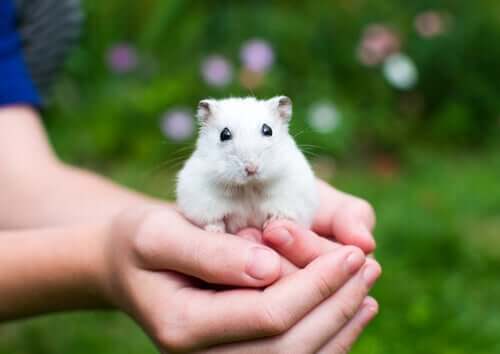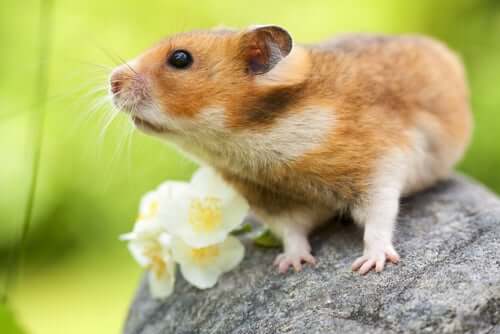All You Need To Know About the Behavior of Hamsters

When it comes to the most common types of pets, cats and dogs are definitely at the top of the list. And if you opt for another kind of animal, you’re likely to unconsciously expect it to behave the same way a canine or a feline would. However, each pet is unique in its behavior. Today, we’ll talk especially about the behavior of hamsters. That way, you’ll know just what to expect if you decide to have one as a pet.
To make it easier to understand the behavior of hamsters, we’ll analyze several of their characteristics in the following article.
Gain in-depth knowledge about the behavior of hamsters
Hamsters are nocturnal animals, which makes them very different from dogs and cats. For that reason, their behavior is quite different as well. Let’s look at the movements they make and what these movements mean.
Licking
It may come as a surprise to know that hamsters lick themselves. When they do, they start with their feet, and then move onto the rest of their body. A hamster that puts an effort into grooming is a hamster that’s happy and secure.

Stretching
Stretching and yawning are two of the most characteristic traits when it comes to the behavior of hamsters. When hamsters stretch and yawn, it means that they’re happy. What’s more, it’s a sign that they’re comfortable in the place where they are and with the people around them.
Sitting
You may observe your hamster sitting on its hind legs, almost as if standing, with its ears straight up. This means that your tiny pet is listening attentively to what you’re saying, as well as to other noises in the environment.
Marking
Hamsters are also territorial animals, and therefore like to mark their space. They possess a scent gland that is in the center of their bodies, in their abdomen or, in other words, in their belly.
Sounds
There are various different sounds that hamsters make, which include chirping or squeaking. This particular sound means that they are nervous or afraid. It happens especially when they arrive at a new place. However, once they get used to their new surroundings, the sound will cease.
When hamsters gnash their teeth, this means they are announcing that they’d rather be alone. In this case, we recommend you avoid picking them up, as they may end up biting you.
When hamsters hiss, they go into a position similar to that of a cat. They squat down, open their mouths, and raise their front paws. This means that they are very afraid and feel threatened.
Biting the bars of their cage
When a hamster bites the bars of its cage, it’s an attempt to get your attention. Often, hamsters will do this in the afternoon or evening, which is when they feel most lonely. In order to prevent this from happening, put toilet paper between the bars or give them something else to gnaw on.
What to do if your hamster bites your hand
Biting their owner’s hands is normal behavior when it comes to hamsters. Normally, they do this because they can smell food residue on your hands. So, before picking your hamster up or petting it, make sure to wash your hands thoroughly… Especially if you’ve been handling food.
Also, remember that every animal needs time to become domesticated. Therefore, patience is key.
Tips for modifying a hamster’s behavior
Hamsters have a tendency to run away. If yours does, then you can set food out on different spots of the floor. Also, remember to be extra careful when walking around the house. The last thing you want to do is accidentally step on your pet!

Something that many hamster owners ask themselves is if they can modify their pet’s behavior when it comes to going to the loo. The answer is yes! You can train your hamster to go to the bathroom in a specific location. The best way is to purchase a mini toilet in a pet store to place in your animal’s cage.
Inside, place garbage and bedding soaked in urine. Then, place your hamster on top and let nature take its course.
As you can see, every species is unique, and hamsters’ behavior is different to that of other pets. If you have a hamster or are thinking of getting one, remember that having a pet is a big responsibility. Give your hamster the love and care it needs.
When it comes to the most common types of pets, cats and dogs are definitely at the top of the list. And if you opt for another kind of animal, you’re likely to unconsciously expect it to behave the same way a canine or a feline would. However, each pet is unique in its behavior. Today, we’ll talk especially about the behavior of hamsters. That way, you’ll know just what to expect if you decide to have one as a pet.
To make it easier to understand the behavior of hamsters, we’ll analyze several of their characteristics in the following article.
Gain in-depth knowledge about the behavior of hamsters
Hamsters are nocturnal animals, which makes them very different from dogs and cats. For that reason, their behavior is quite different as well. Let’s look at the movements they make and what these movements mean.
Licking
It may come as a surprise to know that hamsters lick themselves. When they do, they start with their feet, and then move onto the rest of their body. A hamster that puts an effort into grooming is a hamster that’s happy and secure.

Stretching
Stretching and yawning are two of the most characteristic traits when it comes to the behavior of hamsters. When hamsters stretch and yawn, it means that they’re happy. What’s more, it’s a sign that they’re comfortable in the place where they are and with the people around them.
Sitting
You may observe your hamster sitting on its hind legs, almost as if standing, with its ears straight up. This means that your tiny pet is listening attentively to what you’re saying, as well as to other noises in the environment.
Marking
Hamsters are also territorial animals, and therefore like to mark their space. They possess a scent gland that is in the center of their bodies, in their abdomen or, in other words, in their belly.
Sounds
There are various different sounds that hamsters make, which include chirping or squeaking. This particular sound means that they are nervous or afraid. It happens especially when they arrive at a new place. However, once they get used to their new surroundings, the sound will cease.
When hamsters gnash their teeth, this means they are announcing that they’d rather be alone. In this case, we recommend you avoid picking them up, as they may end up biting you.
When hamsters hiss, they go into a position similar to that of a cat. They squat down, open their mouths, and raise their front paws. This means that they are very afraid and feel threatened.
Biting the bars of their cage
When a hamster bites the bars of its cage, it’s an attempt to get your attention. Often, hamsters will do this in the afternoon or evening, which is when they feel most lonely. In order to prevent this from happening, put toilet paper between the bars or give them something else to gnaw on.
What to do if your hamster bites your hand
Biting their owner’s hands is normal behavior when it comes to hamsters. Normally, they do this because they can smell food residue on your hands. So, before picking your hamster up or petting it, make sure to wash your hands thoroughly… Especially if you’ve been handling food.
Also, remember that every animal needs time to become domesticated. Therefore, patience is key.
Tips for modifying a hamster’s behavior
Hamsters have a tendency to run away. If yours does, then you can set food out on different spots of the floor. Also, remember to be extra careful when walking around the house. The last thing you want to do is accidentally step on your pet!

Something that many hamster owners ask themselves is if they can modify their pet’s behavior when it comes to going to the loo. The answer is yes! You can train your hamster to go to the bathroom in a specific location. The best way is to purchase a mini toilet in a pet store to place in your animal’s cage.
Inside, place garbage and bedding soaked in urine. Then, place your hamster on top and let nature take its course.
As you can see, every species is unique, and hamsters’ behavior is different to that of other pets. If you have a hamster or are thinking of getting one, remember that having a pet is a big responsibility. Give your hamster the love and care it needs.
All cited sources were thoroughly reviewed by our team to ensure their quality, reliability, currency, and validity. The bibliography of this article was considered reliable and of academic or scientific accuracy.
- Royal Society for the Prevention of Cruelty to Animals (2014) How to take care of your hamster. Recuperado el 8 de enero de 2022, disponible en: https://www.rspca.org.uk/documents/1494939/0/How+to+take+care+of+your+hamster+%28PDF+1.21MB%29.pdf/1fe52927-6265-18e4-1135-6a1a875f7a6a?t=1571906231447
- Royal Society for the Prevention of Cruelty to Animals (sf) How to take care of your hamster. Recuperado el 8 de enero de 2022, disponible en: https://www.rspca.org.uk/adviceandwelfare/pets/rodents/hamsters/environment
- Altamirano, C. (2016) EVALUACIÓN DE DIETAS PROTEICAS DE ORIGEN ANIMAL Y VEGETAL EN LA EFICIENCIA PRODUCTIVA DEL HÁMSTER DORADO (Mesocricetus auratus). (Tesis de grado, Universidad Tecnica de Ambato).
This text is provided for informational purposes only and does not replace consultation with a professional. If in doubt, consult your specialist.








